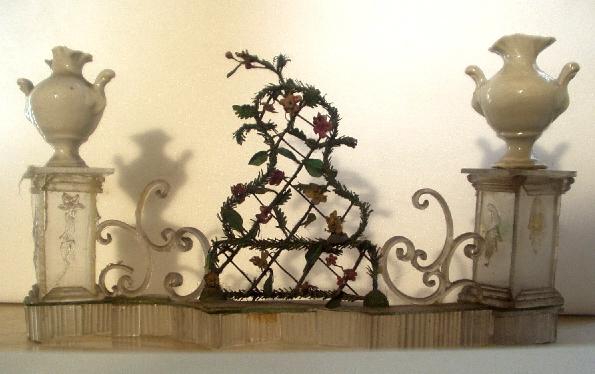Storia del vetro di Murano
I "deseri" di cristallo a Venezia nel SettecentoGlass Dessert Table Settings in Venice in the 18th Century

A Venezia, in occasione di conviti importanti, sulle tavole venivano collocate complesse composizioni con elementi scenografici, come balaustre, archi, fontane, e talvolta figure, tra i quali trovavano posto i piatti degli antipasti, dei dolci e della frutta. Si chiamarono "trionfi" o, con significato pių vasto del termine francese "dessert", "deseri". Potevano essere fatti con materiali diversi (zucchero, cera, porcellana, legno), ma nel Settecento furono fatti soprattutto di vetro.
I mandati di pagamento degli "Ufficiali alle Rason Vecchie", conservati all'Archivio di Stato di Venezia, forniscono interessanti (ma sintetiche) descrizioni dei "deseri", che potevano essere molto grandi (lunghi anche 8 metri) e molto costosi. Poichč la scenografia era realizzata con molti specchi e lastrine di vetro, molti pagamenti vennero fatti ad artigiani specchieri, ma il nome pių spesso legato ai "deseri" č quello di Giuseppe Briati. Ci sono motivi per pensare che il pių famoso vetraio veneziano del Settecento abbia realizzato anche le figurine colorate, in concorrenza con i perlai.

In Venice, when important banquets were held in formal settings, tables were fashionably decorated with complex figural arrangements that displayed dishes of hors d'oeuvres, sweetmeats, and fruit. These decorations were called, in Italian, trionfi (triumphs) or deseri, a term with a much broader meaning than the dessert of French derivation. They could have been made of a variety of materials, such as sugar, wax, porcelain, and wood, but in 18th-century Venice, they were primarily made of glass.
Brief but intriguing descriptions of such glass table decorations are included in the payment records of the Ufficiali alle Rason Vecchie, which are housed in the National Archive of Venice. This office recorded expenses that were incurred when famous figures visited Venice, as well as the values of gifts that Venetian magistrates sent abroad. The records show that the glass decorations could be very large (up to eight meters in length) and very expensive. Most of them were formal garden scenes consisting of fountains, garden paths, flower beds, and trees, surrounded by balustrades, arches, doors, and pedestals with statues. They were illuminated by candles in cornucopias that were mounted in metal boxes.
Mirrors served as the bases for these scenes, which were also constructed with small panes of glass. For this reason, numerous payments were made to mirror makers. The name most prominently associated with the glass gardens is that of Giuseppe Briati, the most famous Venetian glassmaker of the 18th century. A strong case can be made for the argument that Briati, rather than contemporaneous lampworkers, fashioned these table decorations.



Paolo Zecchin Via Cappuccina 13 Mestre Venezia
Glass Dessert Table Settings in Venice in the 18th Century

A Venezia, in occasione di conviti importanti, sulle tavole venivano collocate complesse composizioni con elementi scenografici, come balaustre, archi, fontane, e talvolta figure, tra i quali trovavano posto i piatti degli antipasti, dei dolci e della frutta. Si chiamarono "trionfi" o, con significato pių vasto del termine francese "dessert", "deseri". Potevano essere fatti con materiali diversi (zucchero, cera, porcellana, legno), ma nel Settecento furono fatti soprattutto di vetro. I mandati di pagamento degli "Ufficiali alle Rason Vecchie", conservati all'Archivio di Stato di Venezia, forniscono interessanti (ma sintetiche) descrizioni dei "deseri", che potevano essere molto grandi (lunghi anche 8 metri) e molto costosi. Poichč la scenografia era realizzata con molti specchi e lastrine di vetro, molti pagamenti vennero fatti ad artigiani specchieri, ma il nome pių spesso legato ai "deseri" č quello di Giuseppe Briati. Ci sono motivi per pensare che il pių famoso vetraio veneziano del Settecento abbia realizzato anche le figurine colorate, in concorrenza con i perlai.

In Venice, when important banquets were held in formal settings, tables were fashionably decorated with complex figural arrangements that displayed dishes of hors d'oeuvres, sweetmeats, and fruit. These decorations were called, in Italian, trionfi (triumphs) or deseri, a term with a much broader meaning than the dessert of French derivation. They could have been made of a variety of materials, such as sugar, wax, porcelain, and wood, but in 18th-century Venice, they were primarily made of glass.
Brief but intriguing descriptions of such glass table decorations are included in the payment records of the Ufficiali alle Rason Vecchie, which are housed in the National Archive of Venice. This office recorded expenses that were incurred when famous figures visited Venice, as well as the values of gifts that Venetian magistrates sent abroad. The records show that the glass decorations could be very large (up to eight meters in length) and very expensive. Most of them were formal garden scenes consisting of fountains, garden paths, flower beds, and trees, surrounded by balustrades, arches, doors, and pedestals with statues. They were illuminated by candles in cornucopias that were mounted in metal boxes.
Mirrors served as the bases for these scenes, which were also constructed with small panes of glass. For this reason, numerous payments were made to mirror makers. The name most prominently associated with the glass gardens is that of Giuseppe Briati, the most famous Venetian glassmaker of the 18th century. A strong case can be made for the argument that Briati, rather than contemporaneous lampworkers, fashioned these table decorations.



Paolo Zecchin Via Cappuccina 13 Mestre Venezia
